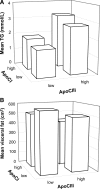Plasma apolipoprotein CI and CIII levels are associated with increased plasma triglyceride levels and decreased fat mass in men with the metabolic syndrome - PubMed (original) (raw)
Plasma apolipoprotein CI and CIII levels are associated with increased plasma triglyceride levels and decreased fat mass in men with the metabolic syndrome
Rachel L M van der Ham et al. Diabetes Care. 2009 Jan.
Abstract
Objective: To determine whether, in accordance with observations in mouse models, high concentrations of the lipoprotein lipase inhibitors apolipoprotein (Apo) CI and ApoCIII are associated with increased triglyceride concentrations and decreased fat mass in men with the metabolic syndrome.
Research design and methods: Plasma ApoCI, ApoCIII, and triglyceride concentrations were measured in the postabsorptive state in 98 men with the metabolic syndrome. Subcutaneous and visceral fat areas were measured by 3T-magnetic resonance imaging.
Results: Triglyceride concentrations were 49% higher, and the average visceral fat area was 26% lower (both P < 0.001), in subjects with high ApoCI and ApoCIII compared with low ApoCI and ApoCIII. Subjects with either high ApoCI or ApoCIII had 16% (P < 0.05) and 18% (P < 0.01) decreased visceral fat area, respectively.
Conclusions: High concentrations of ApoCI and ApoCIII are associated with increased triglycerides and decreased visceral fat mass in men with the metabolic syndrome. These findings translate mouse studies into human pathophysiology.
Figures
Figure 1
Illustration of the inverse relationship of ApoCI and ApoCIII concentrations with plasma triglyceride concentration (positive, A) and with visceral adipose tissue area (negative, B). ApoCI/ApoCIII < median/mean = low, ApoCI/ApoCIII > median/mean = high. Groups: 1: low ApoCI and ApoCIII (n = 35); 2: high ApoCI/low ApoCIII (n = 21); 3: low ApoCI/high ApoCIII (n = 14); 4: high ApoCI and ApoCIII (n = 28). Triglyceride concentration: 1 vs. 3, 1 vs. 4, and 2 vs. 4: P < 0.001. 2 vs. 3: P < 0.01. Visceral adipose tissue area: low ApoCI and ApoCIII vs. high ApoCI and ApoCIII: P < 0.001.
Similar articles
- Elevated Levels of Apolipoprotein CIII Increase the Risk of Postprandial Hypertriglyceridemia.
Guan Y, Hou X, Tian P, Ren L, Tang Y, Song A, Zhao J, Gao L, Song G. Guan Y, et al. Front Endocrinol (Lausanne). 2021 Apr 23;12:646185. doi: 10.3389/fendo.2021.646185. eCollection 2021. Front Endocrinol (Lausanne). 2021. PMID: 33967959 Free PMC article. - Metabolism of very-low-density lipoprotein and low-density lipoprotein containing apolipoprotein C-III and not other small apolipoproteins.
Mendivil CO, Zheng C, Furtado J, Lel J, Sacks FM. Mendivil CO, et al. Arterioscler Thromb Vasc Biol. 2010 Feb;30(2):239-45. doi: 10.1161/ATVBAHA.109.197830. Epub 2009 Nov 12. Arterioscler Thromb Vasc Biol. 2010. PMID: 19910636 Free PMC article. - Apolipoprotein CIII links dyslipidemia with atherosclerosis.
Kawakami A, Yoshida M. Kawakami A, et al. J Atheroscler Thromb. 2009 Mar;16(1):6-11. doi: 10.5551/jat.e607. Epub 2009 Mar 5. J Atheroscler Thromb. 2009. PMID: 19262004 Review. - Inhibition of ApoCIII: the next PCSK9?
Bernelot Moens SJ, van Capelleveen JC, Stroes ES. Bernelot Moens SJ, et al. Curr Opin Lipidol. 2014 Dec;25(6):418-22. doi: 10.1097/MOL.0000000000000130. Curr Opin Lipidol. 2014. PMID: 25255477 Review.
Cited by
- A novel long non-coding RNA connects obesity to impaired adipocyte function.
Lluch A, Latorre J, Oliveras-Cañellas N, Fernández-Sánchez A, Moreno-Navarrete JM, Castells-Nobau A, Comas F, Buxò M, Rodríguez-Hermosa JI, Ballester M, Espadas I, Martín-Montalvo A, Zhang B, Zhou Y, Burkhardt R, Höring M, Liebisch G, Castellanos-Rubio A, Santin I, Kar A, Laakso M, Pajukanta P, Olkkonen VM, Fernández-Real JM, Ortega FJ. Lluch A, et al. Mol Metab. 2024 Oct 1;90:102040. doi: 10.1016/j.molmet.2024.102040. Online ahead of print. Mol Metab. 2024. PMID: 39362599 Free PMC article. - Role of apolipoprotein C1 in lipoprotein metabolism, atherosclerosis and diabetes: a systematic review.
Rouland A, Masson D, Lagrost L, Vergès B, Gautier T, Bouillet B. Rouland A, et al. Cardiovasc Diabetol. 2022 Dec 5;21(1):272. doi: 10.1186/s12933-022-01703-5. Cardiovasc Diabetol. 2022. PMID: 36471375 Free PMC article. Review. - Apolipoprotein C1: Its Pleiotropic Effects in Lipid Metabolism and Beyond.
Fuior EV, Gafencu AV. Fuior EV, et al. Int J Mol Sci. 2019 Nov 26;20(23):5939. doi: 10.3390/ijms20235939. Int J Mol Sci. 2019. PMID: 31779116 Free PMC article. Review. - Apolipoprotein C-I Polymorphism and Its Association with Serum Lipid Levels and Longevity in the Bama Population.
Li Y, Huang Y, Liang X, Long B, Chen S, Lian J, Wei Y, Zhang Z, Qin J. Li Y, et al. Int J Environ Res Public Health. 2017 May 9;14(5):505. doi: 10.3390/ijerph14050505. Int J Environ Res Public Health. 2017. PMID: 28486432 Free PMC article. - Plasma apolipoprotein C-III levels, triglycerides, and coronary artery calcification in type 2 diabetics.
Qamar A, Khetarpal SA, Khera AV, Qasim A, Rader DJ, Reilly MP. Qamar A, et al. Arterioscler Thromb Vasc Biol. 2015 Aug;35(8):1880-8. doi: 10.1161/ATVBAHA.115.305415. Epub 2015 Jun 11. Arterioscler Thromb Vasc Biol. 2015. PMID: 26069232 Free PMC article.
References
- Jong MC, Hofker MH, Havekes LM: Role of ApoCs in lipoprotein metabolism: functional differences between ApoC1, ApoC2, and ApoC3. Arterioscler Thromb Vasc Biol 19:472–484, 1999 - PubMed
- Berbee JF, van der Hoogt CC, Sundararaman D, Havekes LM, Rensen PC: Severe hypertriglyceridemia in human APOC1 transgenic mice is caused by apoC-I-induced inhibition of LPL. J Lipid Res 46:297–306, 2005 - PubMed
- van Dijk KW, Rensen PC, Voshol PJ, Havekes LM: The role and mode of action of apolipoproteins CIII and AV: synergistic actors in triglyceride metabolism? Curr Opin Lipidol 15:239–246, 2004 - PubMed
- Jong MC, Voshol PJ, Muurling M, Dahlmans VE, Romijn JA, Pijl H, Havekes LM: Protection from obesity and insulin resistance in mice overexpressing human apolipoprotein C1. Diabetes 50:2779–2785, 2001 - PubMed
- Duivenvoorden I, Teusink B, Rensen PC, Romijn JA, Havekes LM, Voshol PJ: Apolipoprotein C3 deficiency results in diet-induced obesity and aggravated insulin resistance in mice. Diabetes 54:664–671, 2005 - PubMed
MeSH terms
Substances
LinkOut - more resources
Full Text Sources
Other Literature Sources
Medical
